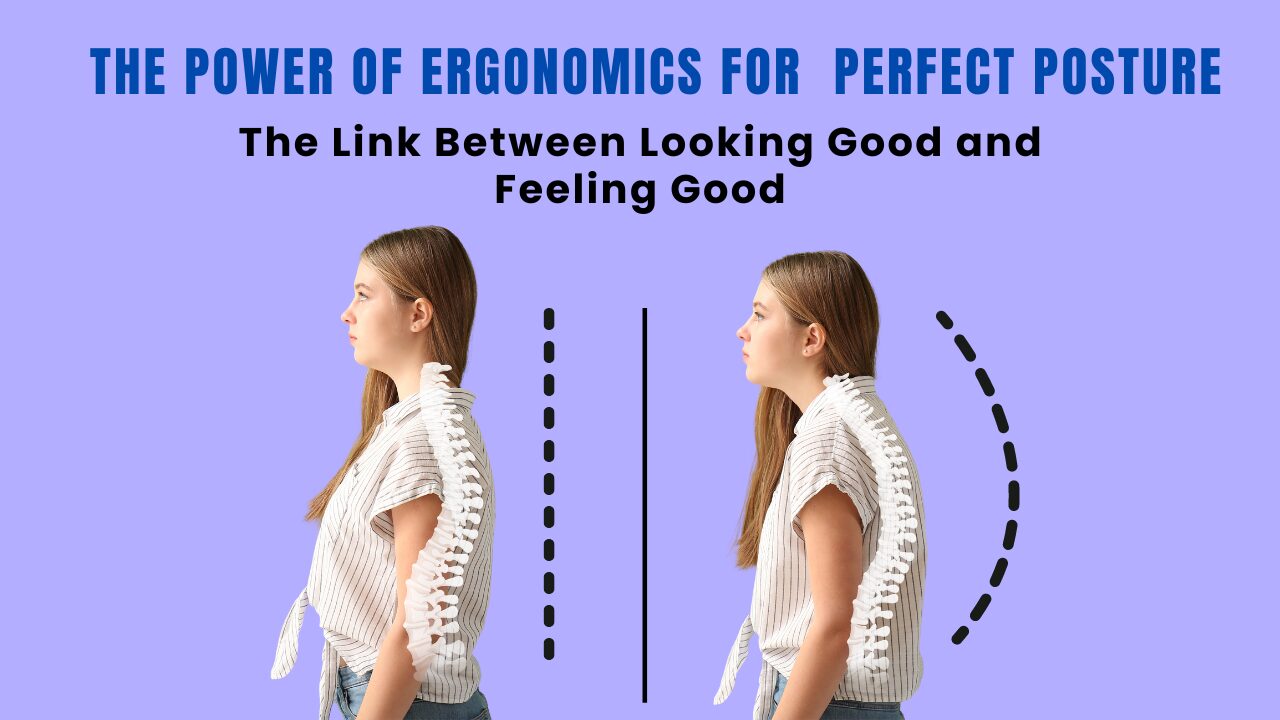The Price of Neglecting Posture
Poor posture can have surprisingly detrimental effects on our physical and mental health. Slouching, hunching over desks, and craning our necks to look at phones puts undue strain on our muscles and skeleton, often leading to chronic back and neck pain. A 2018 study by the National Institute of Arthritis and Musculoskeletal and Skin Diseases (NIAMS) found that 31 million Americans experience low back pain at any given time. This discomfort not only impacts our daily activities but also extracts a steep economic toll—Americans spend at least $50 billion each year to treat back pain.
Beyond physical repercussions, poor posture can diminish mental health and productivity. Slouching restricts lung capacity, reducing oxygen intake, which causes fatigue and diminished concentration. Neck strain from tilting heads forward can result in headaches and mood changes. Poor ergonomics while working on laptops or phones—bending wrists, straining fingers—often cause repetitive strain injuries like carpal tunnel syndrome. A 2015 study published in the International Journal of Industrial Ergonomics linked poor posture to increased stress, negatively impacting work performance.
The effects of neglecting posture permeate our professional and personal lives. Simply put, good posture is foundational to overall health and well-being. Minor adjustments like positioning computer screens at eye-level, taking standing or walking breaks, and performing simple neck and back stretches can yield huge benefits. Rather than an afterthought, healthy posture habits should become second nature. With some knowledge and effort, we can sit straighter, stand taller, and feel genuinely uplifted.
The Power of Ergonomics
The science of ergonomics focuses on designing workspaces and products that match natural human movement and behavior. An ergonomic workspace minimizes stress on the body while maximizing productivity and comfort. Though often associated with office work, ergonomics principles apply to any physical environment.

As per the Occupational Safety and Health Administration (OSHA), applying ergonomics reduces exposure to risk factors like repetitive motion, awkward postures, and improper workstation setups. For example, an ergonomic desk and chair set at proper heights decreases back and neck strain. Ergonomic keyboards with cushions and wrist rests prevent carpal tunnel syndrome. A 2022 study published in Ergonomics India found that incorporating ergonomics in office spaces reduced repetitive motion injuries by 32% and improved efficiency by 19%.
Beyond physical health, ergonomics boosts mental well-being. Per Occupational Ergonomics journal, employees working in ergonomically optimized environments report 22% less stress and take 15% fewer sick days. Simple upgrades like glare-reducing computer screens, noise-minimizing panels, and adjustable lighting restore energy and focus. The National Ergonomics Research Institute of India states that visual distractions, clutter, and poor lighting overwhelm the mind, whereas purposeful ergonomic design clears cognitive load.
We often overlook how our immediate surroundings impact performance. Discomfort decreases concentration. Strains reduce stamina. Incorporating ergonomics allows focusing energy on the work rather than the workspace itself. Thoughtful product and workplace design enables us to maintain better posture, minimize aches, sustain attention, and elevate work. With some awareness and effort, we can create functional environments that support both physical and mental well-being.
Building Your Ergonomic Oasis: A Step-by-Step Guide
Ready to transform your workspace into a haven for comfort and productivity? Let’s dive into creating your very own ergonomic oasis! Here’s a step-by-step guide to setting up essential elements for a healthy and happy work environment:
1. The Throne: Your Chair Matters
Imagine your chair as your loyal work companion. Choose one that offers good lumbar support, meaning it curves inwards to support your lower back. Adjustable features like seat height, armrests, and backrest angle are ideal for finding your perfect “neutral spine” position, where your back is straight and relaxed.
Tip: While high-end ergonomic chairs exist, consider exploring options at different price points. Remember, consulting a professional ergonomist for personalized recommendations is always a good idea!
2. Finding Your Eye Level: The Monitor
Eye strain is a real pain (literally!). Ideally, your computer monitor should be positioned slightly below eye level and an arm’s length away. This helps maintain good posture and prevents neck strain. Consider using a monitor arm to adjust the height and position for optimal viewing comfort.
3. Keyboard and Mouse: The Power Duo
These trusty tools deserve some ergonomic love too! Look for a keyboard with a slight incline and a separate wrist rest to keep your hands in a neutral position. Opt for a mouse that fits comfortably in your hand and offers good wrist support.
4. Standing Tall (Optional): The Standing Desk
Want to switch things up? Consider a standing desk. This allows you to alternate between sitting and standing throughout the day, reducing pressure on your back and promoting better circulation. Remember, even with a standing desk, taking regular breaks and moving around is crucial.
5. Footrests and Accessories: Adding the Finishing Touches
A footrest can help maintain good posture while sitting, especially for people who find their feet dangling. Consider adding other ergonomic accessories like a document holder or keyboard tray to further personalize your comfort zone.
Remember: This is a general guide, and what works for one person might not be perfect for another. Don’t hesitate to experiment and adjust your setup to find what feels best for you. By incorporating these elements and listening to your body, you can create an ergonomic oasis that promotes good health and well-being while you work.
Additional Resources:
- Explore ergonomic product options and features on websites of reputable manufacturers and retailers (avoid directly endorsing specific brands).
- Consult a professional ergonomist for personalized recommendations in setting up your workstation.
Maintaining Posture Perfection Throughout the Day
Creating an ergonomic workspace is the first step, but maintaining good posture all day requires some effort. Small adjustments to your routine can prevent slouching and tension when sitting for long periods.
Take regular microbreaks to get up, stretch, and move around, as recommended by the American Physical Therapy Association (APTA). Every 30-60 minutes, stand up and do shoulder rolls, neck stretches, or hamstring and calf stretches to relieve muscle stiffness. Simple yoga poses like downward dog, child’s pose, and cat-cow stretch the back and core.
Use small props to stay aligned while sitting. Sit on an exercise ball to engage your core and take pressure off the spine. Adjust your chair height so your feet are flat and thighs horizontal, keeping knees and hips at 90 degree angles.
When sitting on the floor working or eating, use cushions to raise your hips above knee level, reducing strain. Take standing breaks every hour or consider investing in a standing desk converter, which studies show boosts productivity.
Practice “active sitting” by consciously engaging your core while working, says yoga teacher Dr. Pramod. Draw your shoulder blades down and back to open up your chest. Look straight ahead with chin parallel to the ground. Regularly repeat this posture reset.
Stay mindful of tension areas like the jaw, shoulders, and hands. Consciously relax them and avoid gripping or pinching motions. Simple tools like stress balls and hand grippers build strength to avoid overuse issues like carpal tunnel syndrome.
With consistent breaks, stretches, and awareness, good posture habits will become second nature. Be patient as your body adjusts. Supporting healthy alignment all day energizes both mind and body for peak performance.
FlexifyMe: Your Personalized Journey to Pain-Free Posture
Imagine a life free from backaches, neck pain, and the discomfort of poor posture. What if there was a way to achieve this, not just in a gym or clinic, but in the comfort of your own home?
FlexifyMe offers a unique solution for individuals seeking personalized guidance on improving their posture and creating an ergonomic workspace. Unlike traditional methods, FlexifyMe leverages the expertise of certified trainers and experienced physiotherapists to design a program tailored specifically to your needs and goals.
Here’s what makes FlexifyMe stand out:
- Personalized Approach: FlexifyMe understands that everyone’s body and lifestyle are unique. Through an initial assessment and ongoing consultations, they create a personalized roadmap to improve your posture, addressing your specific concerns and goals. You can read about Priya’s story: link to FlexifyMe blog post or case study showcasing personalized program and how FlexifyMe helped her overcome back pain and improve her overall well-being.
- AI-Powered Technology: FlexifyMe goes beyond basic posture exercises. Their innovative platform utilizes AI-powered technology to provide real-time feedback on your posture throughout your day, not just during workout sessions. This allows you to make adjustments and improve your posture even while working at your desk or doing everyday activities.
- Convenience and Accessibility: Ditch the inconvenient gym memberships or crowded physical therapy appointments. FlexifyMe‘s program is designed for flexibility and accessibility. You can access personalized guidance and real-time feedback from the comfort of your home, on your own schedule.
Ready to take control of your posture and experience the benefits of a pain-free, comfortable life? Visit the FlexifyMe website or contact them for a free consultation to learn more about their personalized posture solutions.
Remember: FlexifyMe is not about a one-size-fits-all approach. It’s about empowering you with the knowledge and tools to achieve your individual posture goals, leading to a healthier, happier you.


